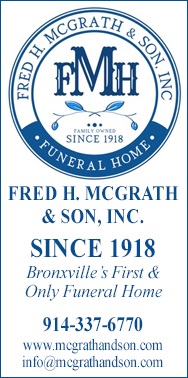Special Letter from Bronxville Board of Education on Flood Mitigation and Reconfiguration of Hayes Field
Written by Bronxville Board of Education

Editor's note: Below is a letter from the Bronxville Board of Education dated December 15, 2014, on the proposed flood mitigation project and the proposed reconfiguration of the school athletic field (Hayes Field). A referendum with two propositions will be held on January 22, 2015, regarding these projects.
To Our Parents, Staff and Fellow Bronxville Residents,
The extraordinary events of the past several years – and the community's resilient response – bear reflection as we prepare to embark on two initiatives that will close this chapter of our district's unique history.
Two 100-year floods within the span of four years caused damage in excess of $30 million, disrupted school and co-curricular activities for months, and wreaked havoc on the school building and neighboring residences. Our community's fortitude allowed us not only to respond meaningfully to these catastrophic events, but also to emerge stronger, better prepared for future challenges, and with better resources than we had prior to 2007.
The District is presenting a referendum for two purposes: the first, to ensure that we receive state and federal funds (a multimillion dollar FEMA grant and state aid) to help offset the final flood mitigation project costs; and the second, to take advantage of the site upheaval caused by the flood mitigation project by improving Hayes Field.
There is only modest cost to District residents associated with the flood mitigation project (about $900,000 in tax-free bonds) and no tax impact associated with improving Hayes Field. Improvements associated with Hayes Field would be paid for with existing capital reserve funds. No new funding is required.
The FEMA grant expires in September 2015, adding urgency to completing the work before school opens next year. Let's take a closer look at the two projects, funding for which voters will be presented with in a special referendum on January 22.
Flood Mitigation
A high water table and the inevitable Bronx River overflows due to heavy rain will always create potential flooding challenges a few times each year. Our task is to manage these realities to mitigate impacts to our physical plant.
The proposed plan is the result of extensive work on the part of the District's facilities committee, representatives of the Village, our engineering and architectural consultants, and other advisors.
The flood remediation project calls for the installation of underground water retention tanks (below Hayes Field) and the construction of a pump house on the Midland Avenue side of the property. In extreme weather conditions that cause flooding, this system will mitigate the impacts to our physical plant by retaining storm water until it is safe to be discharged into the Bronx River.
Hayes Field
To install the flood mitigation system, significant excavation of Hayes Field is required, along with the removal of some trees and the construction of new parking areas required during construction. This enables us to address the chronic shortage of field space, poor condition of Hayes Field from overuse, and limited on-site parking.
Field inventory in the district is quite limited. In 2002, Bronxville sponsored 10 athletic teams and 269 participants. In 2014, we have 24 teams and 523 participants. The natural turf of Hayes Field simply cannot support the demand for use without becoming a degraded safety hazard, which is why, in 2006, Chambers Field was converted to a synthetic surface.
The Board of Education believes that rebuilding Hayes Field with a combination of synthetic turf and natural turf represents the best option for playability and flexibility. Other alternatives that have been studied – including lighting Chambers Field, rebuilding Hayes Field with grass, and leasing grass and synthetic turf fields outside the Village – all come with compromises that far exceed any perceived negative effects of converting a portion of Hayes Field to a synthetic surface.
Some school districts are now considering an organic infill for the synthetic surfaces that they use for school and community programs. We will conduct a comprehensive review of these products and other alternatives and, together with our facilities committee, administration and advisors, make the best choice for our community.
The Board is also focused on three other issues that are meaningful to our school community and Village residents:
Landscaping: A landscape architect will be retained in order to ensure the best possible approach to planting trees surrounding the campus and preserving its character. Approximately 10 trees along Midland Avenue have to be removed to implement the flood mitigation plan, to be replaced by approximately 20 trees and additional shrubbery. On the Meadow Avenue side of the property, two trees will be removed, but approximately 28 new trees will be planted. Over time, a greener presence will manifest itself on our campus.
On-site parking: The current plan calls for a net gain of 29 parking spaces, which will help address our staff and parent needs during the school day, and community needs at all other times. Of these 29 net new spaces, 23 would be located on the district property off Meadow Avenue, adjacent to Hayes Field. Some residents have articulated concerns about the loss of green space to accommodate additional parking. As a result, we are still examining ways to reduce the amount of land used for on-site parking, as well as create the most aesthetically pleasing environment possible.
On-site play areas: Under the current plan, there will be no loss of student play areas on site, including kickball.
We will continue to work with the Village, our advisors, and our professional consultants to refine certain details, including the placement and number of parking spaces and final configuration of the Elementary School play area. Community comment will be welcome.
We encourage you to attend our special meetings in the month of January. We will also be sending information home to all households and posting it to our website.
It has taken seven years to fully respond to the catastrophes that befell our district and community. We hope you will take the opportunity to consider how this final chapter will close the book on a better-prepared and stronger school district.
Sincerely,
Bronxville Board of Education
Letters Directory
Bronxville is a quaint village (one square mile) located just 16 miles north of midtown Manhattan (roughly 30 minutes on the train) and has a population of approximately 6,500. It is known as a premier community with an excellent public school (K-12) and easy access to Manhattan. Bronxville offers many amenities including an attractive business district, a hospital (Lawrence Hospital), public paddle and tennis courts, fine dining at local restaurants, two private country clubs and a community library.
While the earliest settlers of Bronxville date back to the first half of the 18th century, the history of the modern suburb of Bronxville began in 1890 when William Van Duzer Lawrence purchased a farm and commissioned the architect, William A. Bates, to design a planned community of houses for well-known artists and professionals that became a thriving art colony. This community, now called Lawrence Park, is listed on the National register of Historic Places and many of the homes still have artists’ studios. A neighborhood association within Lawrence Park called “The Hilltop Association” keeps this heritage alive with art shows and other events for neighbors.
Bronxville offers many charming neighborhoods as well as a variety of living options for residents including single family homes, town houses, cooperatives and condominiums. One of the chief benefits of living in “the village” is that your children can attend the Bronxville School.
The Bronxville postal zone (10708, known as “Bronxville PO”) includes the village of Bronxville as well as the Chester Heights section of Eastchester, parts of Tuckahoe and the Lawrence Park West, Cedar Knolls, Armour Villa and Longvale sections of Yonkers. Many of these areas have their own distinct character. For instance, the Armour Villa section has many historic homes and even has its own newsletter called “The Villa Voice” which reports on neighborhood news.
Village of Bronxville Administrative Offices
337-6500
Open 9:00am - 4pm excluding holidays and weekends
Bronxville Police Department
337-0500
Open 24 hours
Bronxville Parking Violations
337-2024
Open 9:00am - 4pm excluding holidays and weekends
Bronxville Fire Deparment
793-6400







